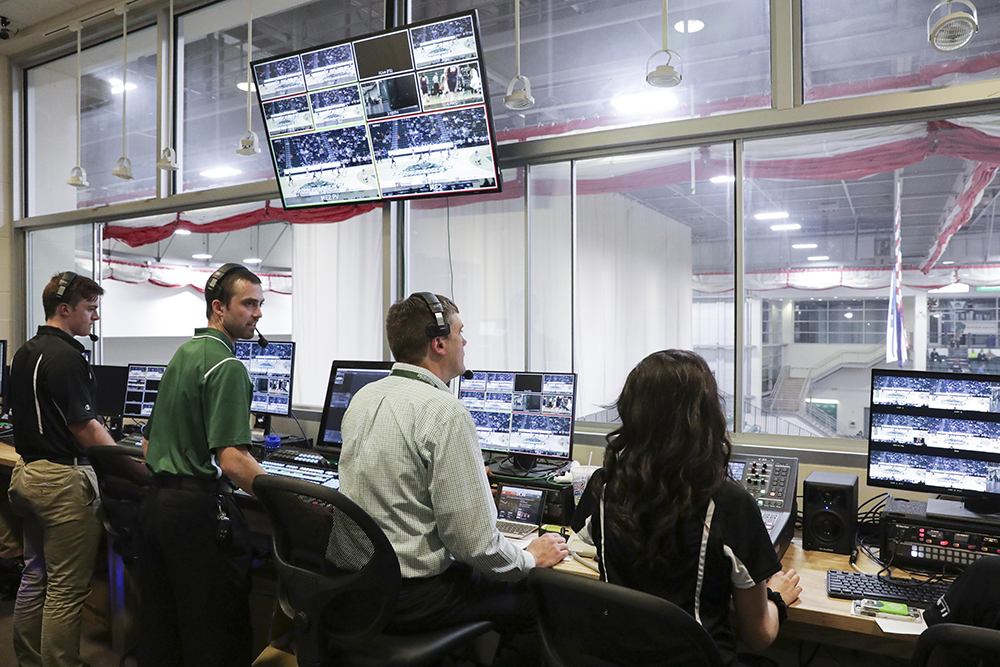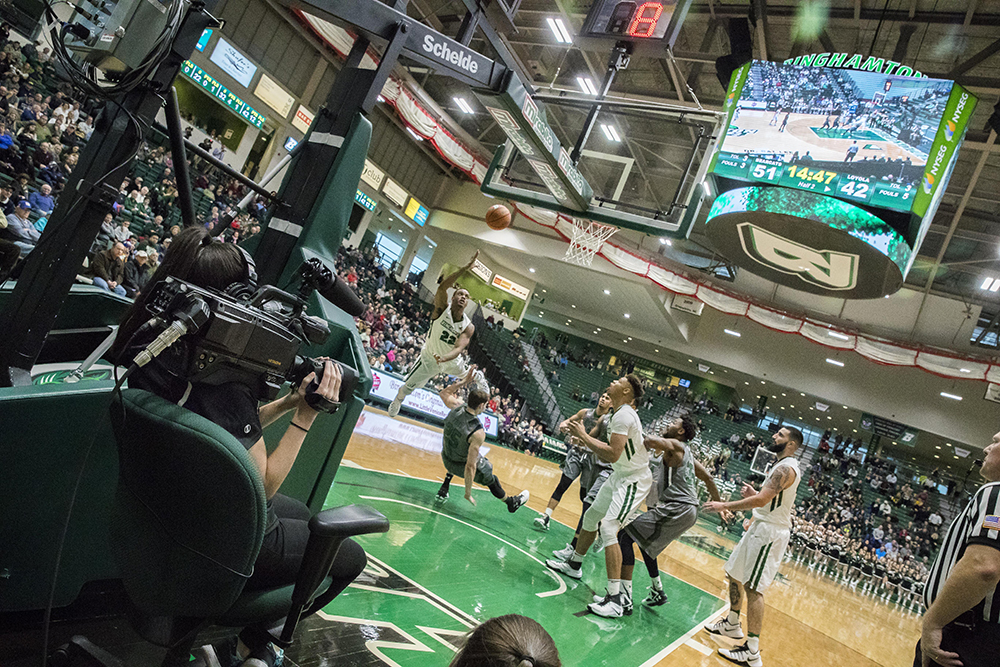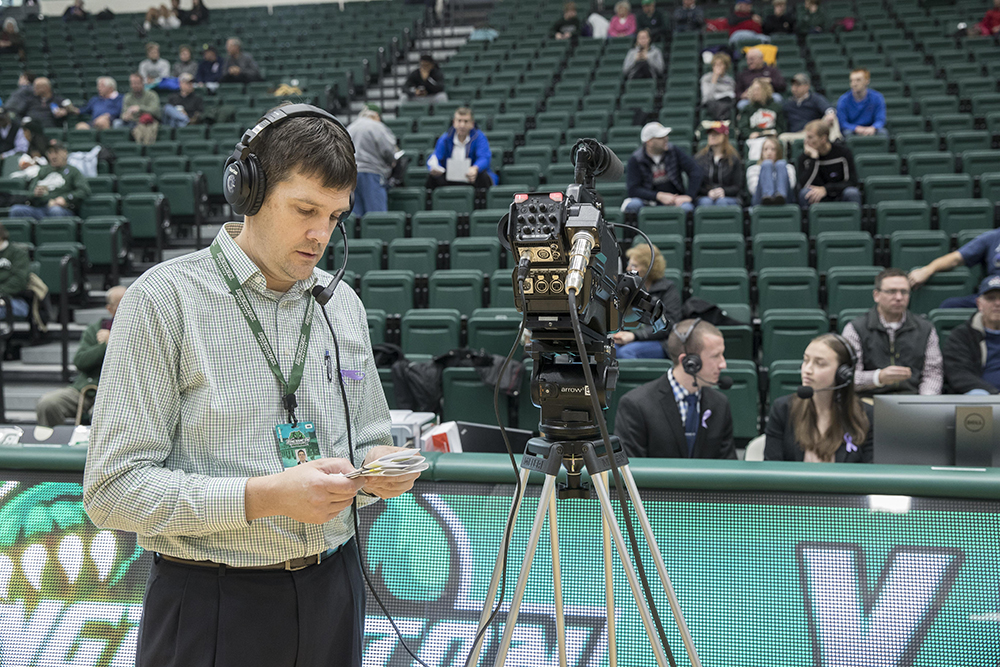A new team in athletics
Students join ESPN3 production team to broadcast Bearcat games

The plan was to replay a thunderous Thomas Bruce dunk when the broadcast of the Binghamton University-Delaware State men’s basketball game went into halftime at the Events Center in mid-December.
It was all queued up and ready when junior guard Yosef Yacob squeezed through two defenders and hoisted an off-balance 3-pointer from the left wing as the buzzer went off.
The ball banked hard off the glass and went in.
“We need that. Replay, replay,” technical director Dave Van Gorder from the Binghamton Athletics Department and freelance TV producer Bob Ide said in unison in the television control room above the hardwood.
Alyssa Fiore, also a junior, instinctively tapped a few buttons and spun a wheel with her right thumb on her control pad. On two of the 12 video feeds in front of her, players streaked in reverse, abruptly halted and then smoothly rolled through the clang of the rim and snap of nylon in high definition.
“You got it,” she said.
In seconds, Yacob’s shot — which was one of eight 3-pointers Binghamton hit in the 85-66 win — was replayed to the ESPN3 audience.
Most Division I athletic events broadcast around the country on the ESPN networks are produced by professionals. At Binghamton University, the production crew — including camera, soundboard, graphics and replay operators — is primarily students.
“Our team is as sharp as any production crew in the country,” said Senior Associate Athletic Director Dennis Kalina, who oversees the broadcasts. “We purchased a lot of new equipment in the summer of 2016. It was installed in September and October, and there weren’t too many people around who knew how to use it. So we had to bring together a team to learn how to do it. Some of them come in during their free time just to practice doing graphics or getting quicker on replays. I bet there are some coaches who wished they had players who wanted to practice as much.”
“It definitely took some time to learn how to operate the replay technology,” said Matthew Fedorchak, who is in the fast-track MBA program. He was one of the students getting in extra reps on the replay machine on nongame days. “I was nervous cutting highlights for the first game. Practice is the key.”
Hitting the shot before halftime was impressive, but Yosef has been working on his game for about 15 years. Fiore learned how to cut basketball replays in about six weeks.
“My brother is a production coordinator for ESPN, and he inspired me to go into the field. It can be nerve-wracking to cut in-game replays because everything is so fast-paced, and if you make a mistake it gets aired on live TV,” Fiore said. “It’s a great team to be a part of; this is the first time most of us have done anything like this, so we’re all figuring things out together.”
Even though broadcasting on the ESPN3 platform is new, and the current crew had to learn how to operate the new equipment quickly, the Athletics Department has live streamed home basketball games online since 2007. Soccer, lacrosse, volleyball and wrestling have been online since 2008. Currently, about 100 home events in 10 different sports are live streamed in some capacity. The average viewership per broadcast is usually 200-700 depending on the sport and opponent.
Without traditional journalism, broadcast or sports administration majors on campus, being active behind the scenes of a game fills a learning gap for students who want to work in athletics or broadcasting. Students aren’t pigeonholed either, as they rotate through responsibilities like replay, graphics, and camera work. Thus far, the top two chairs in the booth (director and producer) and courtside (play-by-play and color commentary) are filled by professionals, but students could fill those jobs in the future, according to Kalina.
“My dream job is to be a sports reporter or broadcaster at ESPN, and as soon as I saw the application for this internship, my eyes lit up,” said Izabel Pasquale, a freshman English, literature and rhetoric major who works the graphics station next to Fiore. “When I first started, I was very nervous about messing up the graphics for ESPN3 because we are live. But plenty of people told me that it is OK to mess up, and professionals do it all the time. I am not all that nervous anymore since the best way to learn is from your mistakes.”
“This is a great opportunity to learn more about the production side of sports,” Fedorchak said. “We definitely have fun during the games. It takes a total team effort to run a successful ESPN3 broadcast. The producers, cameras, replay and graphics operators all have to be on the same page throughout.”
All of the ESPN3 broadcast work is mirrored by a second student crew controlling the video displays inside the Events Center. The in-house team also makes sure officials have good replays to refer to, that sponsors’ logos and in-game stats are accurate, and that interactive games are shown during timeouts to keep fans entertained.
With the proximity of the Bearcats Sports Complex to the Events Center, Kalina and the crew plan to give lacrosse and soccer games the new broadcast treatment. Baseball, softball, volleyball and wrestling are also on the future docket since much of the equipment is mobile.
“This is just the beginning for us,” Kalina said. “We are going to lose some good people to graduation, but we are going have to bring in new students to take over those roles.”
“I guess you could say that we are going to have to recruit students to fill out our team, just like the teams that we are broadcasting these games for.”



